Scientific Revolution and Enlightenment Halos
Scientific Revolution and Enlightenment Halos: Unveiling the Mysteries of Atmospheric Optics
The phenomenon of halos has captivated human curiosity for centuries. These ethereal rings of light encircling the sun or moon have been observed since ancient times, but it wasn't until the Scientific Revolution and The Enlightenment that a testable and predictive understanding of their origin began to take shape.
Descartes' Ice Crystal Theory
One of the earliest attempts to explain halos came from René Descartes in 1637. He proposed that ice crystals were responsible for their formation. According to Descartes, sunlight passing through lens-like ice particles would create a 22-degree halo. However, his theory had its flaws. The halo he described would have a bright sky inside, whereas the real 22-degree halo is characterized by a dark sky within its boundaries.
Huygens' Revolutionary Model
It was Christiaan Huygens, the Dutch natural philosopher, who published the first quantitative explanation of halos in 1667. Although he lacked direct evidence due to the absence of microscopes at the time, Huygens theorized that ice particles took the shape of cylinders and spheres. To account for the dark sky within the halo, he introduced the concept of opaque cores within these ice particles. By aligning the cylinders horizontally and vertically, Huygens successfully explained the formation of sundogs and tangent arcs.
Huygens' groundbreaking work went beyond mere speculation. He computed the resulting shapes of halos and found that they matched well with observations. His model introduced the concept of crystal orientation and made testable predictions that aligned with reality. This marked a significant milestone in the study of atmospheric optics and the birth of mathematical physics.
Mariotte's Prism Theory
In 1679-81, Edme Mariotte, a distinguished French academician, presented an alternative theory for halos. He replaced Huygens' arbitrary cylinders and spheres with equilateral ice prisms with a 60-degree angle. While Mariotte's model represented a step forward, it lacked substantial evidence to support the use of prisms in halo formation. Unfortunately, his theory was overshadowed by the reputation of Huygens, highlighting the challenges faced by alternative ideas in the scientific community.
Newton's Enigmatic Manuscript
Isaac Newton, the secretive genius of Trinity College, Cambridge, also delved into the study of halos. Although initially thought to have contributed nothing to the field, recent discoveries have shed light on his involvement. Science historian Alan Shapiro compared Newton's published work, "Opticks" (1704), with its pre-publication manuscript. Surprisingly, the manuscript contained a different explanation for the 22-degree halo, one that closely resembled the modern understanding of halo formation. Newton proposed that double triangular ice prisms formed rhomboidal shapes on the ends of dendritic snowflakes. However, before publication, he crossed out his own explanation and endorsed Huygens' theory instead. The reasons behind this change remain a subject of speculation, but it raises questions about the influence of established figures in shaping scientific discourse.
Young's Breakthrough: Hexagonal Prisms
It wasn't until 1807 that Thomas Young, a polymath known for his contributions to various fields, arrived at a major breakthrough in halo science. Young proposed that hexagonal prisms were the fundamental shape of ice crystals responsible for generating halos. His theory provided an explanation for the upper tangent arc and later extended to encompass the 46-degree halo as well. With Young's discovery, the basic concepts of cloud ice crystals, their special alignment, and hexagonal prism shapes were firmly established. This allowed for systematic investigation and understanding of halos, as well as the prediction of new types of halos.
The Impact of the Scientific Revolution and The Enlightenment
The Scientific Revolution, spanning from Copernicus to Newton, and The Enlightenment, which flourished in the late 17th to early 19th centuries, played pivotal roles in advancing the study of atmospheric optics. During this period, thinkers like Descartes, Huygens, Mariotte, Newton, and Young challenged long-held beliefs and delved into the mysteries of halos. Their inquiries not only expanded our understanding of these mesmerizing optical phenomena but also paved the way for the birth of mathematical physics. By combining empirical observations with mathematical analysis, they laid the foundation for a science that would go on to transform the world.
In conclusion, the journey towards unraveling the secrets of halos spanned centuries and involved the contributions of numerous brilliant minds. From Descartes' initial ice crystal theory to Huygens' revolutionary model, Mariotte's prism theory, Newton's enigmatic manuscript, and finally Young's breakthrough with hexagonal prisms, each step brought us closer to comprehending these awe-inspiring atmospheric optics. The Scientific Revolution and The Enlightenment provided the intellectual framework necessary for these advancements, highlighting the power of curiosity, observation, and mathematical reasoning in shaping our understanding of the natural world.
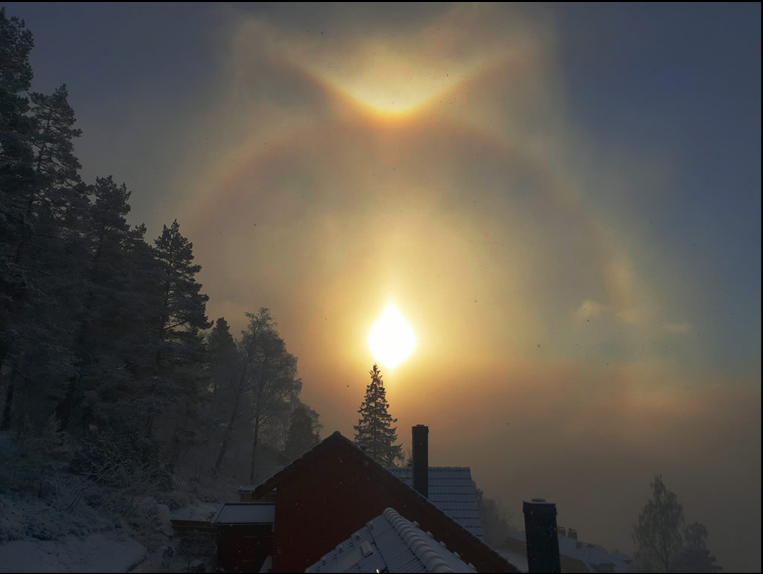
Revolutionary Halos
A gorgeous diamond dust ice halo display imaged in Oslo by Steinar Midtskogen.
A 22 degree halo circles the sun. It is topped by a V-shaped upper tangent arc. Above that is just a hint of a rare Parry arc.
Recorded since at least Babylonian times, a testable and predictive understanding of their origin had to await the Scientific Revolution and The Enlightenment.
Image ©Steinar Midtskogen, shown with permission
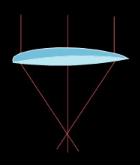
Descartes suggested that ice crystals produced halos. Those making the 22° halo were thicker in the centre and so produced a cone of light. Millions of them could produce a circular halo but it would be of arbitrary size. Worse, the sky inside the halo would be bright. The sky inside the real 22° halo is dark.

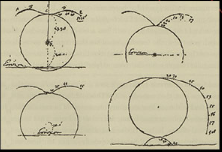
Huygens' halo model. Ice cylinders and spheres form the halos. Their central dark cores block light and form the halo edges.
He introduced the concept of aligned crystals in clouds. Vertical cylinders give sundogs. Horizontal columns form tangent arcs.
Huygens computed the halos formed. His predictions were good. Compare how Huygens' tangent arcs (at left) compare with modern ray tracings.
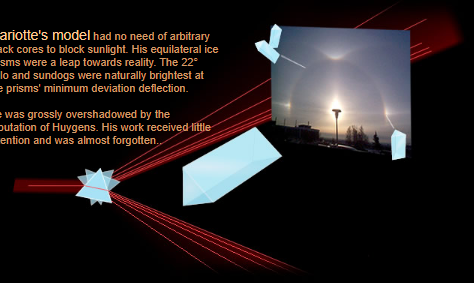
Mariotte's model had no need of arbitrary black cores to block sunlight. His equilateral ice prisms were a leap towards reality. The 22° halo and sundogs were naturally brightest at the prisms' minimum deviation deflection.
He was grossly overshadowed by the reputation of Huygens. His work received little attention and was almost forgotten..

Secretive Newton's model was never published and exits only in manuscript form. It was likely developed before 1670. If so, it precedes that of Marriotte and is contemporary with Huygens'.
.He correctly reasons that the radius of a 22° halo corresponds to minimum deviation through a 60° ice prism. He posits two such prisms forming rhomboidal shapes on the ends of dendritic snowflakes.
He almost published this in his Opticks of 1704 but shortly beforehand he crossed it out and replaced it by a shorter explanation endorsing Huygens. Another case of intimidation by a figure of authority?
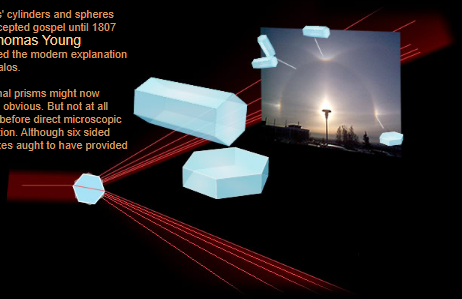
Huygens' cylinders and spheres were accepted gospel until 1807 when Thomas Young developed the modern explanation for ice halos.
Hexagonal prisms might now seem so obvious. But not at all obvious before direct microscopic observation. Although six sided snowflakes aught to have provided a clue!
Some steps to halo science...
The Greeks were, of course, curious about halos. Anaximander of Miletus (610 � 546 BC) tore them from the gods. Thunder, rain, lightning, atmospheric phenomena were of natural causes he held. They were explainable. They were no longer incomprehensible divine acts. Brave - and at that time very discomforting.
Later, Anaxagoras (c510 � c428 BC) held that halos were not real objects like clouds but were the �shining back� (anti-lampon) of rays. Reflections? Remember, Greek rays came from the eye.
Aristotle (384 � 322 BC) repeats the reflection idea. �Now then, the reflection of the sight comes about in this way when the air and vapour condense into a cloud, if the vapour, which has been condensed, happens to be uniform and constituted out of small particles.� Small particles in clouds! Ice crystals?
Then he spoils it! �The complete circle of the halo appears often and comes about around the sun and moon and also around the luminous ones of the stars.� 22� halos around stars are much too dim to be visible even in the non-light polluted skies of Ancient Greece. But bright stars and planets do form visible coronae. Was Aristotle actually talking about coronae? Or both? It illustrates the dangers of cherry picking appealing phrases and assuming they meant the same to the Greeks.
Then things stop. For 2000 years. As in other sciences, the dead weight of the esteem held for Aristotle contributed. Plus dogma, the comfort from certainties rather than discomfort, scepticism and curiosity from an awareness of ignorance.
Further progress awaited the Scientific Revolution (Copernicus to Newton) and The Enlightenment (late 1600s - early 1800s) it helped engender.
R�ne Descartes in 1637 suggested that ice crystals produced halos. Sunlight shining through lens-like ice particles made the 22� halo. They could, but only if the right shape. A problem was that the halo�s inside would be bright rather than dark.the darker sky inside the real halo is sometimes called a 'hole in the sky'.He appears not to have made a mathematical analysis. That is surprising because he produced the first quantitative model of rainbow formation. One that stands to this day.
Christiaan Huygens, the Dutch giant of natural philosophy, published in 1667 the first ever quantitative explanation of halos. He assumed the ice particles were cylinders and spheres. He had no evidence because it was too early for the microscope. Clear cylinders and spheres cannot make halos but give them opaque cores of just the right size and they do! This neat innovation explained the 22� halo. Orient the cylinders horizontally and vertically and you have sundogs and the tangent arcs. He had introduced the concept of halos produced by special alignments.
All this was no arm waving. Huygens computed the resulting halo shapes and they compared well with reality. We should not laugh at his dark centred cylinder model. It introduced crystal orientation. It made testable predictions that agreed with observation.
Taken together with Descartes� description of the rainbow we see curiosity about atmospheric optics helping the birth of mathematical physics, a science that changed the world.
Edme Mariotte was a distinguished French academician who independently discovered Boyle�s gas law. He presented a rival halo theory in 1679-81, replacing Huygens' arbitrary cylinders and spheres with 60� prisms. We might cheer at the advance � but he had no more evidence for his shapes than did Huygens.
Mariotte�s model was soon disregarded. As with Aristotle, we see the reputation of Huygens stifling rival ideas. Science is not the impartial dispassionate discipline that it likes to portray.
Isaac Newton. What did the secretive genius of Trinity College, Cambridge do about halos while Huygens and Mariotte published their ideas?
Nothing. Or so we thought until relatively recently..
Science historian Alan Shapiro has compared Newton's 1704 Opticks book with its draft manuscript. In the book the 22� halo only gets a small paragraph supporting Huygens� theory. Yet the pre-publication manuscript contains quite a different explanation. Newton attributes 22� halo formation to double triangular ice prisms (rhomboidal shapes). The explanation is almost the modern one. As he more or less stopped work on optics after 1670 it�s likely that his explanation came much earlier. His �Lectiones opticae� of 1670-2 mainly about prism phenomena could have contained it. This lecture series was a condition of his appointment as Lucasian Professor. It was probably forgotten as he was not an entrancing lecturer. �So few went to hear Him, & fewer yt understood him, yt oftimes he did in a manner, for want of Hearers, read to ye Walls.�
Why in about 1704 did he cross out his own halo explanation and replace it by one endorsing Huygens? Was even Newton intimidated by the stature of an established proponent?
Huygens� cylinder and sphere theory, now supported in print by Newton, reigned for some 140 years.
Thomas Young, was a polymath. He developed a theory of vision, contributed much to the decipherment of Egyptian hieroglyphs and produced strong evidence for the wave nature of light. In 1807 he arrived at hexagonal prisms as the form of ice crystals generating halos and explained the upper tangent arc. With Henry Cavendish, who weighed the Earth, he went on to explain the 46� halo.
We were finally there. The basic concepts - (1) cloud ice crystals, (2) their special alignment and (3) hexagonal prism shapes - were in place and proven. Halos could now be systematically investigated and understood one by one and new ones predicted.
My thanks to Roy Bishop for alerting me to the Shapiro paper.
Some reading:
Johnson, Monte The Aristotelian Explanation of the Halo, APEIRON, 325-358, (2009)
Newton, Isaac Opticks 1704
Rovelli, Carlo Anaximander (2011)
Shapiro, Alan Newton and Huygens' Explanation of the 22° Halo, Centaurus 24, 271-287 (1980)
Tape, Walter Atmospheric Halos and the Search for Angle X (2006)
Westfall, Richard The life of Isaac Newton (1993)
Note: this article has been automatically converted from the old site and may not appear as intended. You can find the original article here.
Reference Atmospheric Optics
If you use any of the definitions, information, or data presented on Atmospheric Optics, please copy the link or reference below to properly credit us as the reference source. Thank you!
-
<a href="https://atoptics.co.uk/blog/scientific-revolution-and-enlightenment-halos/">Scientific Revolution and Enlightenment Halos </a>
-
"Scientific Revolution and Enlightenment Halos ". Atmospheric Optics. Accessed on April 18, 2024. https://atoptics.co.uk/blog/scientific-revolution-and-enlightenment-halos/.
-
"Scientific Revolution and Enlightenment Halos ". Atmospheric Optics, https://atoptics.co.uk/blog/scientific-revolution-and-enlightenment-halos/. Accessed 18 April, 2024
-
Scientific Revolution and Enlightenment Halos . Atmospheric Optics. Retrieved from https://atoptics.co.uk/blog/scientific-revolution-and-enlightenment-halos/.